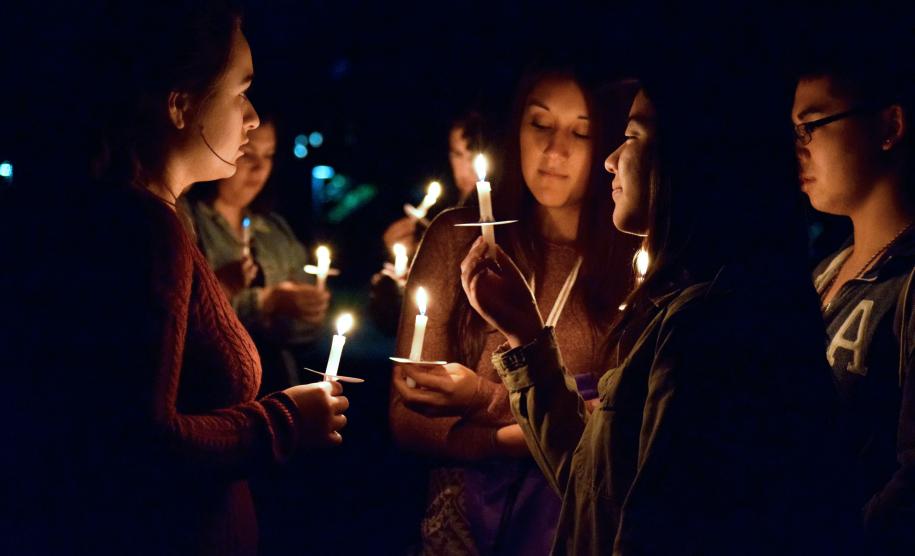
Breadcrumb
- Essential Partners
- Our Impact
- News and Notes
- Dialogue on Sexual Assault
Dialogue on Sexual Assault

April on college campuses represents the beginning of spring as well as the end of semester flood of assignments and exams as the year comes to an end. That’s not all that’s going on in April, however. Many schools are now engaged in activities around Sexual Assault Awareness Month: survivors have a chance to tell their stories and students have the opportunity to engage in challenging conversations about sexual assault, relationship violence, and campus culture. A survey commissioned by the Association of American Universities on sexual assault on college campuses found that 1 in 4 college women will experience some form of unwanted sexual at some point during their college years. While April certainly shines a spotlight on the issue, sexual assault and related issues are being hotly discussed all year on college campuses. In April and beyond, how are college students, faculty, and administrators talking about sexual assault?
A hot topic on campus
As a college senior, this topic has been of particular interest to me even before I began working on it for Essential Partners. Like diversity, it is one of the most prevalent issues on campus. As my university hosted events to spread awareness and facilitate conversation this past week, I reflected on my conversations with several administrators from different schools, all of whom are all working on Title IX and sexual assault on their campuses. What they shared helped me to understand how colleges are currently talking about the issue and which conversations are being neglected.
More media, more movement
The increased attention that Title IX and sexual assault on campus has been gaining for the past several years has put more pressure on college administrators to address the issue. Individual universities have been coming under greater scrutiny for their practices in handling sexual assault by both the media and the government. In 2014, the Obama administration placed 55 public and private universities under investigation for failing to comply with Title IX Since then, the subject of sexual assault has exploded in the media landscape, generating numerous newspaper articles, books, movies, and other popular media. John Krakauer’s Missoula, a powerful and meticulous narrative on a series of sexual assaults at the University of Montana and the 2015 documentary The Hunting Ground, an expose about rape on college campuses, are just two of the more prominent works that have come out of this growing media attention.
Engaging in dialogue
The good news is that at least in part due to the conversations that added scrutiny has inspired, students and administrators are talking about this issue on campus through formal and informal means more than ever. According to one Title IX administrator from the Boston area, sexual assault prevention is most successful when it is a “collaborative and iterative process” that involve the partnership of different stakeholders on campus. This includes raising awareness, teaching students how to keep themselves and their friends safe, and having adequate response teams in administration, law enforcement, and health services in the event that sexual assault does occur. One university embodied this idea of a collaborative and iterative process when it involved representatives from students, faculty, and administrative groups in revising its Title IX policies. This kind of opportunity allowed students to feel as though “they had agency and ownership in the process” and that their ideas were heard and taken into account. The schools that are most successful in sexual assault prevention have created multiple avenues such as this through which students, faculty, administrators, and law enforcement can discuss the issue, build trust, and maintain accountability.
Where is conversation about sexual assault happening?
Conversations about sexual assault take many forms on college campuses. Bystander Intervention is the most widespread avenue for conversation on this is an issue. Teaching students to intervene in questionable situations they see that could result in sexual assault, programs like these focus largely on providing students with skills to recognize potentially risky situations and to safely intervene or diffuse the situation. Students can also participate in self-defense classes or student awareness and activism groups that focus on bringing attention to the problem with the intent of starting a conversation. Although programs like bystander intervention don’t address the problem from all angles, such as discussing underlying gender norms, it does serve as a good way to encourage proactive conversation amongst students.
Where do we need more conversation?
A conversation lacking at many schools is the opportunity for discussions about healthy relationships, masculinity, and social norms. Sexual assault prevention is an “intrapersonal as well as an interpersonal problem,” said a women’s center program coordinator, meaning that students need to be able to explore their own internal influences and motivations. Conversations that help students explore the pressure to conform to gender norms or learn what healthy relationships actually look like are important in helping students to understand one another and “build a strong culture for each other,” as one Title IX administrator in New Hampshire pointed out. I have seen these on my own campus through student discussion groups about masculinity, sporadic events about gender norms, and even just this past week, a panel on healthy relationships. Creating more opportunities for students to learn and discuss these underlying problems helps students to connect with others, building that culture for others. Genuine curiosity and caring about other people’s experiences and how other people experience things can enhance the feeling of community and address sexual assault as not just an interpersonal problem, but also as an intrapersonal one.
About the Author: Natasha Dobrott is an intern at Essential Partners.